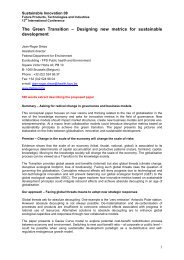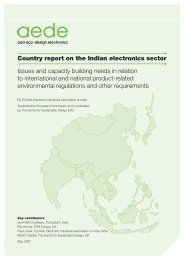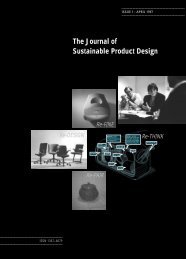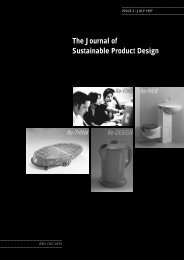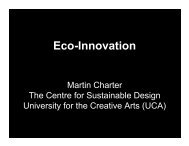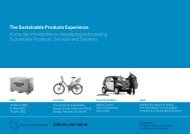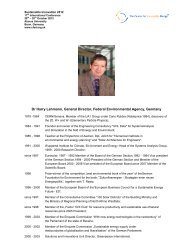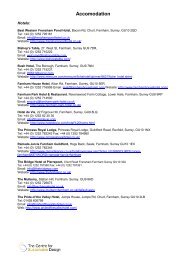acrobat JSPD 8 - The Centre for Sustainable Design
acrobat JSPD 8 - The Centre for Sustainable Design
acrobat JSPD 8 - The Centre for Sustainable Design
Create successful ePaper yourself
Turn your PDF publications into a flip-book with our unique Google optimized e-Paper software.
INNOVATION<br />
Emma Prentis is a Director of<br />
Conservation Communications. She<br />
was previously European Environmental<br />
Manager with in Nortel’s corporate<br />
environment and sustainability function<br />
with responsibility <strong>for</strong> developing<br />
strategy and programmes to support<br />
Nortel’s marketing aned strategic<br />
business planning functions. Prior to<br />
joining Nortel, Ms Prentis worked with<br />
BT <strong>for</strong> seven years. She has a Masters<br />
in Environment Science and is a<br />
Director of the UK Institute of<br />
Environmental Management (IEM).<br />
Hedda Bird joined Conservation<br />
Communications in 1986 and was<br />
appointed Managing Director in<br />
1988. She has developed the<br />
company from a specialist promotor of<br />
recycled paper products to a leading<br />
environmental communications and<br />
research consultancy. Ms Bird has an<br />
MSc in Mathematics and Philosphy<br />
from London University and recently<br />
obtained an MBA from Warwick<br />
University in the UK.<br />
52 THE JOURNAL OF SUSTAINABLE PRODUCT DESIGN · JANUARY 1999<br />
Customers – the<br />
<strong>for</strong>gotten stakeholders<br />
Emma Prentis and Hedda Bird|<br />
Director and Managing Director Conservation<br />
Communications, UK<br />
<strong>The</strong> paper suggests that consideration<br />
of customers is usually<br />
excluded from strategic environmental<br />
thinking. However,<br />
customers hold the key to the<br />
environment team’s strategic<br />
‘added value’ as they drive the<br />
business. <strong>The</strong> authors give practical<br />
advice on how to ‘green’<br />
marketing, using an example of<br />
work completed with Nortel.<br />
Introduction<br />
Environmental activity in<br />
organisations must demonstrate<br />
market (ie. customer)<br />
value if they are to deliver the<br />
genuine, fundamental change in<br />
business behaviour that is<br />
required by the concepts of<br />
‘Business Sustainability’ and the<br />
‘triple bottom line’. <strong>The</strong> need to<br />
clearly identify market value<br />
from environmental activities is<br />
well understood; however, it is<br />
often regarded as being too<br />
difficult or just plain impossible.<br />
Indeed the ability to make a<br />
bottom-line case <strong>for</strong> strategic<br />
environmentalism is fast becoming<br />
the Holy Grail of the environmental<br />
business movement.<br />
A variety of methods are<br />
currently used to show the<br />
financial benefits of improved<br />
environmental per<strong>for</strong>mance;<br />
these include:<br />
· supply chain management<br />
· operational cost avoidance<br />
and cost savings<br />
· continuous improvement<br />
and quality management<br />
· stakeholder dialogue<br />
· ‘<strong>Design</strong> <strong>for</strong> Environment’<br />
(DfE).<br />
All of these are valid activities<br />
that can deliver environmental<br />
and financial business benefit.<br />
However the authors of the<br />
paper argue that while benefits,<br />
can and do, accrue from these<br />
actions the business value of<br />
these activities are rarely strong<br />
enough on their own to<br />
influence strategic business<br />
thinking and direction. For<br />
example, cost savings rarely<br />
trans<strong>for</strong>m overall company<br />
results. Indeed corporate strategy<br />
makers regard continuous<br />
cost improvement as part of<br />
operational per<strong>for</strong>mance indicators.<br />
A Board of Directors will<br />
not cost reduce itself into a new<br />
strategic direction! Thus if<br />
‘Environment’ is about cost<br />
cutting, it will not be presumed<br />
to have anything to add to strategy<br />
development.<br />
Similarly stakeholder dialogues<br />
by many organisations do not<br />
include customers in the



